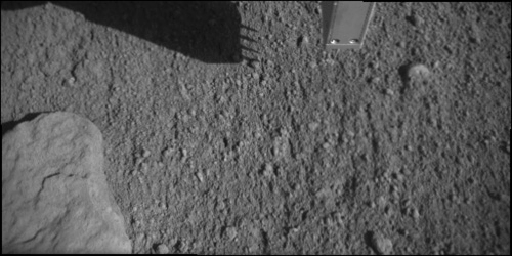
|
Phoenix Conductivity Probe Inserted in Martian Soil
- Click the image above for a larger view
 Movie Download Options
Movie Download Options- Full-Res JPEG (512 x 256) (43.0 kB)
- Full-Res TIFF (512 x 256) (131.4 kB)
Caption:
This series of six images from the Robotic Arm Camera on NASA's Phoenix Mars Lander records the first time that the four spikes of the lander's thermal and electrical conductivity probe were inserted into Martian soil.
The images were taken on July 8, 2008, during the Phoenix mission's 43rd Martian day, or sol, since landing. The insertion visible from the shadows cast on the ground on that sol was a validation test of the procedure. The spikes on the probe are about 1.5 centimeters or half an inch long.
The science team will use the probe tool to assess how easily heat and electricity move through the soil from one spike to another. Such measurements can provide information about frozen or unfrozen water in the soil. The probe is mounted on the "knuckle" of Phoenix's Robotic Arm. It has already been used for assessing water vapor in the atmosphere when it is held above the ground.
Background Info:
The Phoenix Mission is led by the University of Arizona, Tucson, on behalf of NASA. Project management of the mission is led by NASA's Jet Propulsion Laboratory, Pasadena, Calif. Spacecraft development is by Lockheed Martin Space Systems, Denver.
Photojournal Note: As planned, the Phoenix lander, which landed May 25, 2008 23:53 UTC, ended communications in November 2008, about six months after landing, when its solar panels ceased operating in the dark Martian winter.
Cataloging Keywords:
| Name | Value | Additional Values |
|---|---|---|
| Target | Mars | |
| System | ||
| Target Type | Planet | |
| Mission | Phoenix | |
| Instrument Host | Phoenix Lander | |
| Host Type | Lander | |
| Instrument | Robotic Arm Camera (RAC) | |
| Detector | ||
| Extra Keywords | Atmosphere, Grayscale, Movie, Shadow, Thermal, Water | |
| Acquisition Date | ||
| Release Date | 2008-07-11 | |
| Date in Caption | 2008-07-08 | |
| Image Credit | NASA/JPL-Caltech/University of Arizona/Max Planck Institute | |
| Source | photojournal.jpl.nasa.gov/catalog/PIA10941 | |
| Identifier | PIA10941 | |
